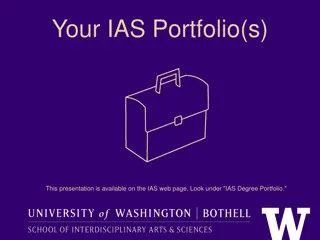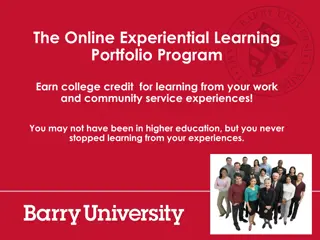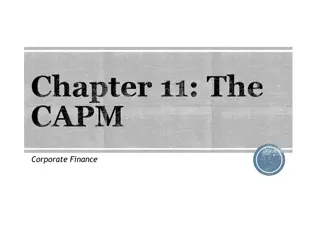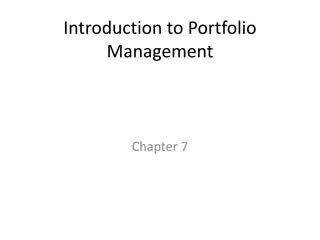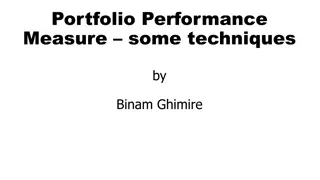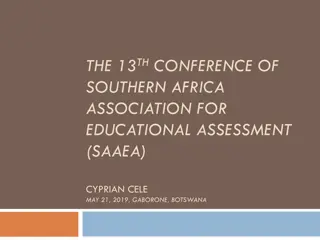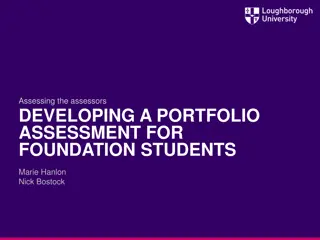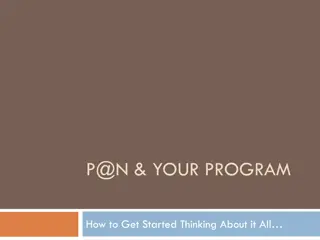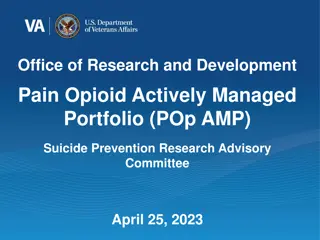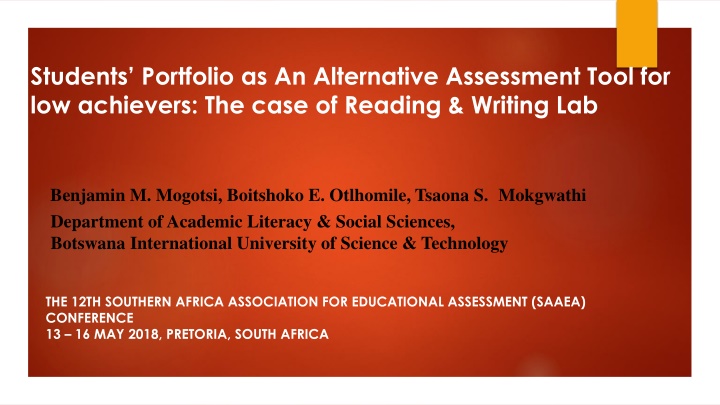
Using Student Portfolios as Alternative Assessment Tool for Low Achievers
Exploring the effectiveness of student portfolios as an alternative assessment tool for low achievers in a remediation project aimed at improving reading and writing skills. The study discusses the benefits of portfolio-based assessment over traditional testing methods and the impact on student learning outcomes.
Download Presentation

Please find below an Image/Link to download the presentation.
The content on the website is provided AS IS for your information and personal use only. It may not be sold, licensed, or shared on other websites without obtaining consent from the author. If you encounter any issues during the download, it is possible that the publisher has removed the file from their server.
You are allowed to download the files provided on this website for personal or commercial use, subject to the condition that they are used lawfully. All files are the property of their respective owners.
The content on the website is provided AS IS for your information and personal use only. It may not be sold, licensed, or shared on other websites without obtaining consent from the author.
E N D
Presentation Transcript
Students Portfolio as An Alternative Assessment Tool for low achievers: The case of Reading & Writing Lab Benjamin M. Mogotsi, Boitshoko E. Otlhomile, Tsaona S. Mokgwathi Department of Academic Literacy & Social Sciences, Botswana International University of Science & Technology THE 12TH SOUTHERN AFRICA ASSOCIATION FOR EDUCATIONAL ASSESSMENT (SAAEA) CONFERENCE 13 16 MAY 2018, PRETORIA, SOUTH AFRICA
Introduction BW s attainment of 10-year Basic education led to AP Automatic progression policy meant weak learners go to junior secondary school Resulting in continued failure HENCE introduction of RAWL by BIUST as a community initiative project Reading And Writing Lab (RAWL) is a remediation project (targeting grade D & below in PSLE) Various assessment methods are used in language teaching to create learning spaces that assist low achieving learners Student portfolio - an assessment tool is gaining popularity (Birgin & Baki, 2007; Birgin, 2003; De Fina, 1992; Gussie, 1998; Micklo, 1997) PA is based on contemporary learning approaches eg. constructivist, co- constructivist, multiple-intelligences and brain-based learning theories.
Portfolio (LR) 1. A cumulative and ongoing collection of entries that are selected and commented on by the student, the teacher and/or peers, to assess the student s progress in the development of a competency (Simon & Forgette-Giroux , 2000:36) . 2. A collection of student s work over a period of time (e.g., term, semester or an academic calendar year) that is designed to show student work over that period of time. Such progress may include documentation of a learner s knowledge and abilities (Short, 1993) 3. A systematic collection of student work and related material that depicts a student's activities, accomplishments, and achievements in one or more school subjects. (Alabdelwahab, 2002) The goal of PA is to help students assemble portfolios that illustrate their talents, represent their writing capabilities, and tell their stories of school achievement... (Venn, 2000, pp. 530-531) Portfolio-based assessment offers a viable alternative to traditional, standardized, high stakes testing.
Literature review cont Research shows portfolio benefits (Birgin & Baki, 2007; Birgin, 2007; Mokhtari et al., 1996; Mullin, 1998; Sweet,1993): It provides multiple ways of assessing students learning over time; It provides for a more realistic evaluation of academic content than pencil-and paper tests. It allows students, parent, and teacher to evaluate the students strength and weakness. (BW s Multiple pathways). It provides multiple opportunities for observation and assessment (Birgin & Baki, 2007) It provides an opportunity for students to demonstrate his/her strengths as well as weakness.
Literature review cont It encourages students to develop some abilities needed to become independent, self-directed learners It also helps parents see themselves as partners in the learning process. It allows students to express themselves in a comfortable way and to assess their own learning and growth as learners. It encourages students to think of creative ways to share what they are learning It increases support to students from their parents and enhances communication among teachers, students and parents. It encourages teachers to change their instructional practice and it is a powerful way to link curriculum and instruction with assessment
Purpose of the Study To assess the effectiveness of Student Portfolio as an alternative assessment strategy for teaching English to low achieving learners at a junior secondary school.
Problem Statement Despite Curriculum change from Behaviourist approach to learner-based outcome approach, the mode of assessment remains unchanged leading to a contradiction/mismatch. (Misalignment) Conventional assessment approaches to teaching & learning of English are ineffective because of their failure to equip & assess 21stcentury skills(collaborative problem solving skills) (Birgin & Baki, 2007) These methods only assess cognitive skills / basic knowledge. (Birgin & Baki, 2007) Hence the study proposed a Student portfolio as an alternative tool of assessment.
Research Question Does Student Portfolio assessment help improve the instructional outcomes of junior secondary school low achieving learners?
Theoretical framework Study uses Co- Constructivist approach to examine effectiveness of portfolio as an alternative assessment tool in language classes (Klenowski, Askew and Carnell; 2006) Emphasis is on collaborative learning over individual learning ((Birgin & Baki, 2007) Learners are encouraged to identify issues in their learning process that affect their learning goals According to Birgin & Baki (2007) in the process, the following competencies are taught: -cognitive flexibility -Communications skills -Creativity -Critical thinking & complex problem solving
Theoretical framework cont Students are given an opportunity to comment on, evaluate and make recommendations on how learning can be improved through students evaluation of elected class activities (Venn, 2000); learning, in this model involves reflective processes, critical investigation, analysis, interpretation and re-organisation of knowledge (Venn, 2000; Birgin & Baki, 2007) Feedback informs teachers on how to improve content and mode of delivery (Birgin & Baki, 2007)
Research Design Data collected through: - Students interviews/portfolio conferences - Teachers Questionnaire - Researchers observations - Document analysis/student journals. Study Participants: 50 form two (Grade 9) in RAWL remediation class-(F=23, M=27) 10 English Language teachers (F=4, M=6)
Portfolio Assessment Criteria Portfolio organization Neatness Attitude towards learning Evidence of growth Achievement of specific curricular objectives Student reflections
Results Students: -86% of students indicated that portfolios were helpful in identifying strengths and weakness in their learning (Reading, listening, speaking & Writing competencies) -Evidence of improved interaction & communicative skills -PA has improved team work and interpersonal skills Teachers: -Current assessment is based on traditional standardized testing( Knowledge Testing) -Despite RNPE encouraging innovative learner-centred teaching, assessment is still based on informational testing (Rep. of BW,1999 (a):3) -Cluster monthly tests and exams are targeted at the promotion of learners to the next level. -Parental support for such a new assessment system is absent -Parents do not show commitment to their children s school work (laziness by teachers)
Summary & Conclusion Teachers see PA as a worthwhile burden with tangible results in instruction and student motivation. PA enables students to reflect on performance, to show their weak and strong domain, PA encourages students to take responsibility for own learning. Teachers observe student s progress during learning process, PA places new demands on teachers eg. professional dev, time to learn portfolio, preparation time to create new materials and lessons to produce a self-programmable learner (SPL) (Price etal. ,2011) Using both PA & other assessment methods will enable a more reliable information about students performance.
Recommendations Teachers should use PA along side traditional assessment methods to produce expected products of BW curriculum (comm. skills, interpersonal skills, work activity skills) CD&E and BEC must make PA part of English language assessment strategies Teacher training & In-service training on PA use is needed Teachers who tend to use portfolios should be trained before, assisted and supported in the portfolio application process by experts. PA can be used in assessing Speaking skill, which at the moment it is not assessed.
QOUTE!!!!! The function of education is to teach one to think intensively and to think critically. Intelligence plus character that is the goal of true education. Martin Luther King, Jr. Thank you Taboka Sibongile Kelebogile Xie xie



